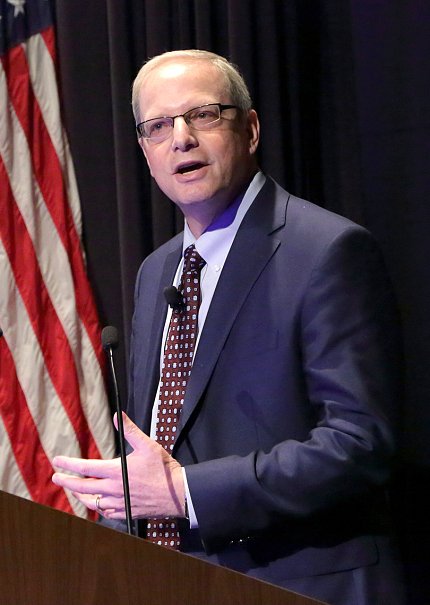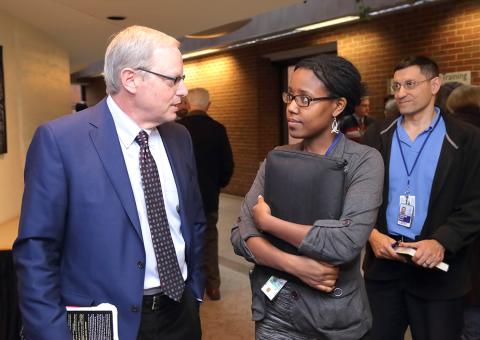The Digital Doctor
Health Care IT May Need a Reboot, Wachter Says

Photo: Ernie Branson
In today’s high-tech world, doctors increasingly have their heads buried in their computers. While they’re feverishly typing in patient data, digitally prescribing medicines and reviewing electronic health records, personal relationships are deteriorating. Digitized health care has left many doctors and their patients literally not seeing eye to eye.
Dr. Robert Wachter, chief of the division of hospital medicine at the University of California, San Francisco, is decidedly not a Luddite. He blogs, tweets and lauds the potential for technology to improve patient care. In fact, “I would not today go to a hospital that didn’t have a good computer system,” said Wachter, also professor and interim chair of UCSF’s department of medicine. “There’s no question in my mind that our [world] is safer than before we computerized. But there are unanticipated consequences.”
When a computer error nearly killed a child at UCSF, Wachter decided to explore the pitfalls and promise of health care IT, as described in his recent book The Digital Doctor: Hope, Hype, and Harm at the Dawn of Medicine’s Computer Age. There was not an empty chair in Lipsett Amphitheater during his recent CC Great Teachers Grand Rounds.
A Terrifying Mistake
Health care IT should help prevent human error. But 2 years ago, Wachter recounted, a 16-year-old boy at UCSF Medical Center nearly died when he received a massive overdose of a common antibiotic. A doctor had typed in an order for one 160-mg pill. But after a pharmacist called for a clarification, the doctor went back into the computer to confirm the order, one of the system’s built-in safety measures. But she didn’t realize the order screen had defaulted to milligrams per kilogram, based on the child’s weight in kg. So she keyed in “160”—thinking she was ordering 160 mg, but she actually was ordering 160 mg/kg. The impact? An order for 39 pills.
The state-of-the-art IT system did send out overdose warnings, but the doctor and pharmacist both missed them. How? Because all of the clinicians—doctors, nurses and pharmacists—have grown immune to all the alerts, particularly since so many are false alarms. In 1 month in the ICUs at UCSF, the monitors threw off more than 2.5 million alerts, most inconsequential.
Stunned by these reports of alert fatigue, Wachter visited Boeing to ask airplane engineers about cockpit alerts. He learned they spend thousands of hours in simulated flight testing with pilots before releasing the planes for commercial use. During testing, they remove unnecessary alerts so pilots pay attention to every alert, which could mean the difference between life and death.

Photo: Ernie Branson
The nurse who administered the 39-fold overdose thought the amount seemed unusual but figured it must be correct. After all, the doctor and pharmacist cleared the order. And when she scanned the first pill in her barcode scanner, it signaled to her that the correct dose was 39 pills, further convincing her that the order was right. The teenager took each and every pill, then had a massive seizure and stopped breathing. Incredibly, he survived.
Is There a Doctor in the House?
In 2008, Congress appropriated $30 billion toward computerizing health care. If done right, electronic health records and other health IT advances have the potential to deliver high-value care, said Wachter. But going electronic has left many doctors’ offices and hospitals unprepared to cope with changes in work flow and patient care.
“In just the last 5 years, American health care has gone from an industry whose information backbone was the Post-it note, the clipboard and the 3-ring binder, to an industry whose backbone is electronic,” said Wachter.
He recounted going on rounds as a medical student, learning a great deal from discussing films with the radiologist in the chest reading room. Radiology went digital a decade before the rest of health care, Wachter said, because digital films became more cost-effective. But then, these radiology rounds ended. Anyone could see the images anywhere, so they were no longer forced to “go to radiology” to see the only copy of the film.
“I think radiology is a canary in a coal mine,” said Wachter. “It demonstrates the impact of digitization in ways that are often unanticipated and don’t have as much to do with the technology as [with] the people and the work.”
That lost human connection also resonates in patient care, said Wachter. Doctors once lived in their wards, visiting patients, jotting notes in patient charts. Now, he said, hospital hallways look barren; the doctors are all in their quiet rooms, doing their computer work.
Fixing Health Care IT
Much as Boeing engineers observe and interact with pilots when designing cockpit systems, health care IT sorely needs a similar user-centered model. Wachter urges computer vendors to connect with doctors, nurses, pharmacists and patients as they design software to help maximize patient safety. Improving health care IT, he added, will take two keys, like a safe-deposit box. One is better technology. The second, arguably the more important, is to reimagine the work, with technology serving as a tool.
“One of the big things we got wrong here was treating health IT as a technical problem,” said Wachter. “It is a massive adaptive problem…Understanding its impact on jobs and work flow and culture is fundamental to getting this right.”
Wachter, who previously served on Google’s health care advisory board, said Google and other tech companies are transforming health care into an increasingly wired system. Expect the FitBits and Apple watches of the world to soon connect to electronic health records, he said. Expect new apps that will help patients take care of themselves. And as IT generates more and more patient data, he said, researchers will gain a greater understanding of many diseases.
If done properly, Wachter said, such “consumer-facing IT” could be just a few years away. With improvements in current systems and careful planning, health care IT can truly enhance, rather than encumber, the doctor-patient experience.
